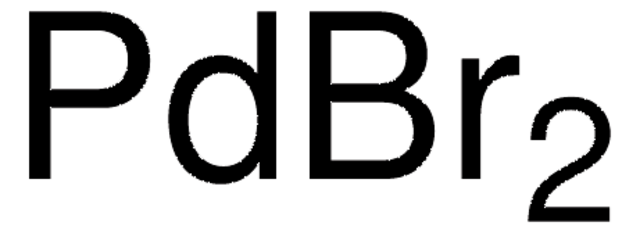76070
Palladium(II) nitrate dihydrate
~40% Pd basis
Synonyme(s) :
Palladium dinitrate hydrate
About This Item
Produits recommandés
Forme
powder or crystals
Pertinence de la réaction
reagent type: catalyst
core: palladium
Concentration
~40% Pd
Chaîne SMILES
O.O.[Pd++].[O-][N+]([O-])=O.[O-][N+]([O-])=O
InChI
1S/2NO3.2H2O.Pd/c2*2-1(3)4;;;/h;;2*1H2;/q2*-1;;;+2
Clé InChI
JUBNUQXDQDMSKL-UHFFFAOYSA-N
Vous recherchez des produits similaires ? Visite Guide de comparaison des produits
Description générale
It is also employed in the fabrication of low-cost solid-state hydrogen storage devices made of three-dimensional (3D) reduced graphene oxide (rGO) and expanded graphite (EG)nanocomposite (NC) decorated with Pd nanoparticles (NPs).
Application
- Doping activated carbon for catalysis
- Catalytic use of hydroxyapatite (HAP) supported Pd nanoclusters in the hydrolysis of ammonia-borane.
It′s used as catalyst for:
- Selective hydrogenation of 1-heptyne and napthalene
- In highly porous coordination polymer MIL-101 support.
It may also be used as a reactant for:
- Preparation of platinum-palladium/carbon alloy nanocatalysts for methanol-tolerant oxygen reduction reaction in fuel cells
- Synthesis of Cu-Pd alloy thin films on Ti substrates by co-electrodeposition of Pd and Cu from nitrate-base electrolytic baths
- Preparation of palladium catalyst supported on vertically aligned multi-walled carbon nanotubes for microwave-assisted Heck reactions of p-iodonitrobenzene with styrene and Et acrylate
- Preparation of di-phenyl sulfide-modified Pd/TiO2 catalysts for acetylene hydrogenation
Mention d'avertissement
Danger
Mentions de danger
Conseils de prudence
Classification des risques
Acute Tox. 4 Oral - Aquatic Acute 1 - Aquatic Chronic 1 - Eye Dam. 1 - Met. Corr. 1 - Ox. Sol. 1 - Skin Corr. 1B
Code de la classe de stockage
5.1A - Strongly oxidizing hazardous materials
Classe de danger pour l'eau (WGK)
WGK 3
Point d'éclair (°F)
Not applicable
Point d'éclair (°C)
Not applicable
Équipement de protection individuelle
Eyeshields, Faceshields, Gloves, type P3 (EN 143) respirator cartridges
Certificats d'analyse (COA)
Recherchez un Certificats d'analyse (COA) en saisissant le numéro de lot du produit. Les numéros de lot figurent sur l'étiquette du produit après les mots "Lot" ou "Batch".
Déjà en possession de ce produit ?
Retrouvez la documentation relative aux produits que vous avez récemment achetés dans la Bibliothèque de documents.
Les clients ont également consulté
Notre équipe de scientifiques dispose d'une expérience dans tous les secteurs de la recherche, notamment en sciences de la vie, science des matériaux, synthèse chimique, chromatographie, analyse et dans de nombreux autres domaines..
Contacter notre Service technique















![[Pd(acac)2] Umicore, 99%](/deepweb/assets/sigmaaldrich/product/structures/145/685/c3d0f078-c0c6-4ce6-9c4a-b6a1b973b3a9/640/c3d0f078-c0c6-4ce6-9c4a-b6a1b973b3a9.png)